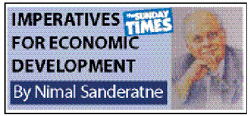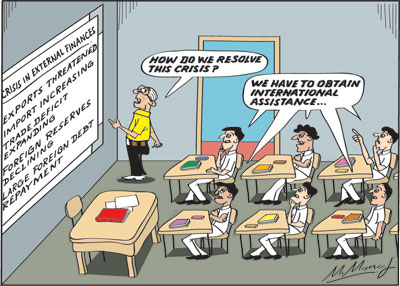Columns
Growing concerns in external finances
View(s): The external finances of the country are in a perilous state. External reserves have fallen, the trade deficit is widening, the balance of payments deficit is increasing and there are foreign debt repayments of about US$ four billion during the rest of the year.
The external finances of the country are in a perilous state. External reserves have fallen, the trade deficit is widening, the balance of payments deficit is increasing and there are foreign debt repayments of about US$ four billion during the rest of the year.
External reserves
External reserves that were US$ 4.47 billion at the end of April have fallen to US$ 4.02 billion at the end of May. The trade deficit expanded at the end of the first quarter and is expected to widen further. This is in a context when foreign debt repayments are about US$ four billion during the rest of the year.
Trade deficit
The trade deficit is widening owing to a decrease in exports and an increase in import expenditure. The country was poised for an increase in merchandise exports as global demand was reviving when the resurgence of the COVID in May disrupted production of export manufactures.
Exports
Exports that were poised to increase owing to a revival of global demand are experiencing a setback owing to the resurgence of the COVID. Last Sunday’s column spotlighted factories working at low capacities or closed down owing to the spread of COVID among workers and travel restrictions.
This was an unexpected turn of fortunes as export industries, especially apparel, were poised to expand to cater to the growing global demand. Garment factories were affected the most by COVID.
 Reduced production
Reduced production
There is growing evidence that manufacturing activities have contracted from May onwards owing to the spread of COVID and restrictions. According to the Central Bank of Sri Lanka there was a “significant contraction in production, employment, new orders and stock of purchases.”
Furthermore, “production, especially in the manufacture of food and beverages and textiles and wearing apparel sectors, declined significantly together with the decline of employment.” This was mainly “due to a significant reduction of availability of employees amidst the mobility restrictions imposed in mid-May.”
Raw materials
It is also significant that there was a “deterioration in accumulated stocks of raw material” according to CBSL. It also notes several other constraints to industrial production such as increased freight rates that have increased the cost of imported raw materials.
Expectation
Although there are expectations of increased manufacturing activities in the next three months, if there is a normalisation of economic activities, at the time of writing, it is unlikely.
Revising targets
Recognising this, the Export Development Board (EDB) is revising its export target downwards from US$ 15 billion. Exports would probably be around US$ 10.5 billion this year.
Threats
There are several serious threats to the country’s exports on the horizon. The foremost is the European Union’s (EU) likely withdrawal of the GSP plus status soon. This would make our exports to the EU less competitive. This is a repetition of the earlier experience when GSP Plus was withdrawn and export growth was stifled till it was revived after the restoration of GSP plus.
Other markets
More threatening is the prospect of other western countries like the UK, Canada and the US imposing trade restrictions or higher tariffs. This would be a disaster as these countries and the EU account for 70 percent of our exports.
Sea food
A ban on our sea food imports is an imminent threat owing to the ocean around the country being poisoned by chemical and oil spill of the burning and sinking of the Xpress Pearl.
Reduced agricultural output
A third threat to exports is from reduced output of tea due to the unavailability of chemical fertilisers, weedicides and pesticides. The impact on coconut production would be from next year. Reduced rubber production would necessitate imports of natural rubber for rubber manufactures like gloves and tyres.
Import increase
Import expenditure is increasing. This is primarily due to increasing prices of oil internationally. Oil prices have increased by as much as 75 percent. Consequently, fuel imports would make a big dent on import expenditure.
Oil imports
The increase in price of petroleum products would ease the public finances somewhat, but will not reduce petrol imports by much due to the inelastic demand for petrol and petroleum-based products. Food imports
The trade deficit would expand due to increased imports of food either later this year or in 2022. Rice production is expected to fall drastically in Yala 2021 owing to the lack of fertiliser, weedicides and pesticides. The Maha 2021/22 drop in production would be larger, unless there is a reversal of import policy on fertiliser, as discussed in the June 6 column.
Silver linings
Amidst these dark economic clouds, there are a few silver linings in the balance of payments. Workers’ remittances that has increased in the first few months are likely to be around US$ seven billion and there is aprospect of an increase in earnings from information technology (ICT) services. In the first quarter of this year, these earnings increased compared to last year.
IMF grant
Another favourable prospect to the balance of payments is the IMF grant of about US$ 800 million in an additional issue of Special Drawing Rights (SDRs) that is expected during the course of the year.
While these earnings would narrow the balance of payments deficit, they are not likely to wipe it out completely.
Summing up
While the country’s export capacity is hampered by the spreading COVID and travel restrictions, import expenditure is increasing. This widening of the trade deficit is likely to continue owing to increased import expenditure and the setback to exports due to production constraints.
Last year the trade deficit was US$ six billion. With an increase in the trade deficit in the first four months of this year, the trade deficit may expand to about US$ eight or nine billion. This may lead to a balance of payments deficit this year.
Conclusion
The country is likely to meet its foreign debt repayment obligations this year by further foreign borrowing, development assistance from multilateral agencies and loan facilities from friendly countries in various forms and the IMF grant. These are temporary means of getting over the severe crisis in the external finances. A crucial determinant of the country’s economic performance is the elimination of COVID.
In the medium and long run the government must get its policies right to increase exports, reduce the trade deficit, enhance earnings from services and increase foreign capital inflows.
The expansion of import restrictions is not a feasible option as it affects production and exports adversely. The adoption of pragmatic economic policies rather than fanciful policies like organic agriculture, excessive creation of money and arbitrary import restrictions are counterproductive for external financial stability.


Leave a Reply
Post Comment